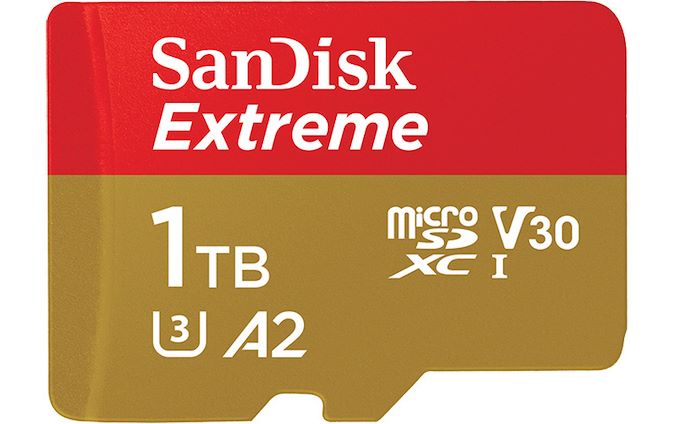SanDisk's First 1 TB microSD Card Now Available
by Anton Shilov on May 16, 2019 9:00 AM EST
Marking a new high in microSD card capacities, Western Digital has started shipping its flagship SanDisk Extreme 1 TB microSDXC card. This is the company's (and industry's) first 1 TB microSD card, and while the $450 launch price is definitely steep, for portable devices that need a massive amount of storage in a thumbnail-sized removable card, a full terabyte is the biggest step up yet.
When it comes to performance, the memory card is thankfully a member of SanDisk's higher-performing Extreme line, so performance isn't too pokey for reading and writing a full TB out of the drive. Formally, SanDisk rates it for read speeds up to 90 MB/s and write speeds up to 60 MB/s when working over a standard UHS-I interface. This works out to roughly 3 hours and 4.6 hours to read and fill the card, respectively. In fact at this point SanDisk is outright bottlenecked by the UHS bus; the card can actually read at 160 MB/s and write at 90 MB/s when used with proprietary hosts that support DDR transfer modes. So microSD Express and its vastly higher transfer rates can't get here soon enough.
Along with its advertised peak performance, SanDisk's supersized card supports video speed class 30, which among other things means that its minimum write speeds need to be at least 30 MB/s. The card also meets the requirements for the A2 app performance class, meaning that it can sustain at least 4000 random read IOPS and 2000 random write IOPS, and supports capabilities such as command queuing and caching.
Unfortunately for tech enthusiasts, SanDisk isn't saying much about the 1 TB card under the hood. Given the capacity, the card is likely based on the company’s latest 96-layer TLC or QLC 3D NAND memory. But short of tearing it apart, this is hard to confirm.
For the moment the new 1 TB microSD card is available directly from Western Digital for $449.99. But eventually the product will hit regular retail stores too.
Related Reading:
- Micron and Western Digital Unveil 1 TB microSD Cards with A2
- SanDisk Extreme microSD Cards with A2 App Performance Spec Unveiled: 4K/2K IOPS
- HiDisc’s 1 TB SDXC Card with A2 Rating Now at Retail
- ADATA XPG Launches Gaming microSD Cards, up to 512GB
- Lexar Launches 512 GB microSD Card with A2 App Performance Spec
Source: SanDisk (via Tom’s Guide)










21 Comments
View All Comments
Valantar - Thursday, May 16, 2019 - link
They should start rating these giant cards with "time to fill at sustained write" and "time to empty at sustained read" labels. Also, why isn't this UHS-II? I get that not much real-world equipment supports the standard, but it does exist ...Skeptical123 - Thursday, May 16, 2019 - link
Are there UHS-|| microSD cards? "Also, why isn't this UHS-II?" because "SanDisk is outright bottlenecked by the UHS bus". The UHS bus is the interface on the NAND itself. So it would not matter if you had chip connected to a faster port say thunderbolt 3 port because that's not where the speed limit is.wrkingclass_hero - Thursday, May 16, 2019 - link
How many total drive writes would you wager this would last before failure?deil - Thursday, May 16, 2019 - link
15? in real loads where you don't fill all and delete, fill again without load leveling it would be insanely low.porcupineLTD - Thursday, May 16, 2019 - link
If it's TLC it should be able to handle a few hundred TDW.29a - Thursday, May 16, 2019 - link
Why do you think they wouldn't do some sort of wear leveling?baka_toroi - Thursday, May 16, 2019 - link
Isn't SDXC's size limit 2 TB? What will come after it?nandnandnand - Thursday, May 16, 2019 - link
https://en.wikipedia.org/wiki/SD_card#SDUC"The Secure Digital Ultra Capacity (SDUC) format, described in the SD 7.0 specification, and announced in June 2018, supports cards up to 128 TB and offers speeds up to 985 MB/s, regardless of form factor, either micro or full size, or interface type including UHS-I, UHS-II, UHS-III or SD Express. The SD Express interface can also be used with SDHC and SDXC cards."
CharonPDX - Sunday, May 19, 2019 - link
microSD Express. Which is basically NVMe interface in the microSD form factor.imaheadcase - Thursday, May 16, 2019 - link
Should be noted that this is useless in most devices because they have limits on actual SD card size. Very rarely do you even see stuff support 64 or 128gig let alone this.